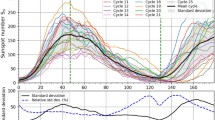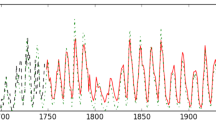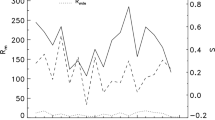Abstract
To make a long-term prediction of the solar cycle in a standard way (GOST 25645.302-83), it is necessary to know the instant of the activity minimum onset, the determination of which is difficult during the decline stage of the previous cycle. The dependence of the long-term prediction error on the time of shift (t) relative to the solar activity minimum instant (i.e., the situation when a certain time before the minimum onset, rather than the time of this minimum, is the initial point of calculations) has been studied. It has been indicated that one should not know the exact time of the activity minimum onset in order to make prediction according to GOST, and such a prediction can be performed with an approximately identical error if the lead time is t ∼ 1 year and more relative to the activity minimum onset. An analysis of the dependence of prognostic W max values on t for cycles 18–23 indicated that prognostic W max values are overestimated at small (to ∼ 1 year) uncertainties in the time of activity minimum onset. It has been obtained that W max = 96 ± 13 for cycle 24 on the assumption that this cycle began in April 2007.
Similar content being viewed by others
References
G. M. Brown and P. A. Simon, “Long-Term Solar Activity Predictions,” in Proceedings of the Workshop on Solar-Terrestrial Prediction, Meudone, France, Boulder, 1984, pp. 1–7.
D. H. Hathaway and R. M. Wilson, “A Synthesis of Solar Cycle Prediction Techniques,” Geol. Soc. Am. Bull. 104, 22 375–22 388 (1999).
D. H. Hathaway and R. M. Wilson, “Geomagnetic Activity Indicates Large Amplitude for Sunspot Cycle 24,” Geophys. Res. Lett. 33, L18101 (2006).
W. W. Pesnell, http://www.sec.noaa.gov/SolarCycle/SC24/May_24_2007_table.pdf
Calculations of Ballistic Satellites. Method for Calculating Solar Activity Indices. GOST 25645.302-83 (Izd. Standartov, Moscow, 1984) [in Russian].
K. H. Schatten and W. K. Tobiska, “Solar Activity Heading for a Maunder Minimum?,” Bul. Am. Astron. Soc. 35, 817 (2003).
K. Schatten, “Fair Space Wather for Solar Cycle 24,” Geophys. Res. Lett. 32(21), GL024363 (2005).
K. Schatten, “Solar Activity and the Solar Cycle,” Adv. Space Res. 32(4), 451–460 (2003).
V. I. Smirnov and I. V. Dunin-Barkovskii, Course of Probability Theory and Mathematical Statistics for Technical Applications, 2nd ed. (Nauka, Moscow, 1965) [in Russian].
Yu. I. Vitinsky, Cyclicity and Prediction of Solar Activity (Nauka, Leningrad, 1973) [in Russian].
Author information
Authors and Affiliations
Additional information
Original Russian Text © A.V. Kryachko, A.A. Nusinov, 2008, published in Geomagnetizm i Aeronomiya, 2008, Vol. 48, No. 2, pp. 153–156.
Rights and permissions
About this article
Cite this article
Kryachko, A.V., Nusinov, A.A. Standard prediction of solar cycles. Geomagn. Aeron. 48, 145–148 (2008). https://doi.org/10.1134/S0016793208020023
Received:
Published:
Issue Date:
DOI: https://doi.org/10.1134/S0016793208020023




